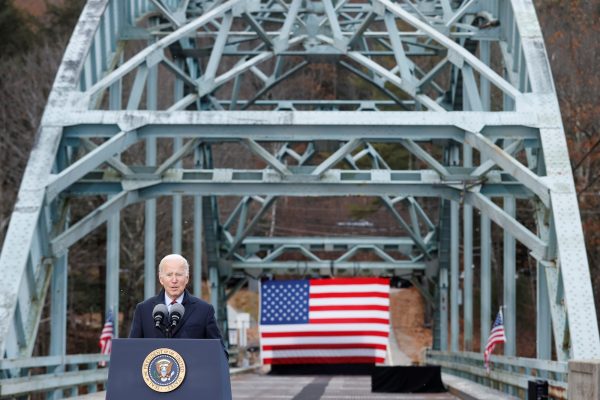It is prevailing wisdom that cities are resurgent in the United States. City leaders are seen to be advancing a host of urgent priorities—economic mobility, climate change, housing affordability, infrastructure investment, and education, among others—at a time when the federal government is trying to roll progress back. Former President Barack Obama, for instance, recently affirmed the power of cities, calling them “the new face of American leadership” on climate change issues.
But it is a mistake to believe that city leaders can accomplish their aspirations on their own.
Cities and suburbs need each other to tackle the major issues of our time.
Most challenges, after all, span multiple jurisdictions. Carbon emissions don’t stop at city borders. Workers look for housing and jobs, consumers buy groceries and other goods, and parents seek out schools for their children across city, county, and even state lines. Cities and suburbs are deeply interconnected and thus need each other to tackle the major issues of our time. The best local climate change plans will reflect regional commuting patterns and industry activities, just as the most effective economic strategies will connect neighborhoods to broader regional opportunities.
With federal investments in health care, research, and workforce training likely to decline, cities and suburbs will also become even more reliant on states. If they don’t present a unified voice to their state governments, local jurisdictions may miss out on vital opportunities to raise new revenue, seek flexibility to pursue regulatory reforms, and coinvest in shared regional priorities. Regional collaborations do already exist, but today’s economic and political realities demand more of them if cities and metro areas are to remain epicenters of national progress.
• • •
Expanding economic opportunity for more people is at the top of most local leaders’ agendas. Even most metro areas, which have experienced widespread economic growth since the Great Recession, have had more uneven gains than top-line trends would indicate. Analysis from the Brookings Institution, for example, found that among the hundred largest metro areas, only eight generated economic growth, rising productivity, and higher wages and employment rates for both whites and workers of color following the recession.
Good jobs that provide pathways to the middle class remain scarce, while the digital economy continues to produce an abundance of low-wage and high-wage jobs. Employers struggle to find skilled labor, hampering business expansion, while millions of adults remain out of the labor market. At the same time, the number of jobs within a typical commuting distance in metro areas has declined, especially for workers living in low-income and minority neighborhoods.
This is not just a concern for city residents. An increasing number of suburban residents now live in poverty, including in neighborhoods with concentrated poverty and racial segregation. Richard Florida calls this the “patchwork metropolis,” where pockets of high- and low-opportunity neighborhoods are interspersed across the city–suburban–exurban landscape.
Thinking and acting regionally is important but notoriously difficult.
The playbook for improving economic opportunity is therefore not only multidimensional but also multi-jurisdictional. To match the scale of what is needed and to make regional markets work better for more people, leaders must help workers gain skills and find jobs, connect employers to qualified workers, support business expansion and quality job growth, modernize transportation and freight networks, and create a variety of housing options. No single mayor or leader can effectively move these levers. At the same time, acting regionally includes being place-sensitive, ensuring that struggling residents and neighborhoods are critical assets in regional prosperity.
The task of making cities and metro areas prosperous and inclusive has grown in urgency as cities continue to gain residents. Since 2010 the 53 largest metro areas have accounted for 93 percent of the nation’s population growth, even though they represent just 56 percent of the overall population. Meanwhile, rural areas are losing residents. This pattern toward urbanization has defined U.S. demography and the modern economy over the past two centuries, and hastens the need for city and regional leaders to make their communities centers of true economic opportunity.
• • •
Thinking and acting regionally is important but notoriously difficult. Metro areas are not single governments, but rather are governed by dozens of elected officials, CEOs, philanthropists, educators, skills providers, neighborhood groups, and other civic actors, each of whom has different self-interests and priorities. Gathering these leaders together to agree on shared challenges and potential solutions—with action—requires significant time and resources.
Successful regional initiatives also carry sizable political risk, can require millions of dollars of public and private funds, and take years, if not decades, to fully implement. It is not hard to understand why many local leaders remain skeptical of calls for regionalism, and why an experienced civic organizer advised leaders to “avoid collaboration if possible.”
Yet the limits of single-jurisdiction approaches are abundantly clear.
To start, jurisdictions that go it alone to expand their economies can make things worse, often at taxpayers’ expense. In metropolitan Kansas City, for example, Kansas and Missouri have used tax incentives to lure companies a mile or two over the state border. As a result, taxpayers in both states are estimated to have lost out on at least $217 million in tax revenue while very few new jobs have been created for the metro area as a whole.
A similar thing happens when sales-dependent jurisdictions green-light a new shopping center to raise local revenue; often, they are simply shifting consumer spending from one jurisdiction to the other, leaving empty stores and distressed neighborhoods in their wake. This jobs-poaching undercuts trust between leaders and makes each jurisdiction both the perpetrator and victim of a zero-sum growth strategy. In contrast, a coordinated regional economic development effort can “grow the pie” by helping existing firms in each jurisdiction innovate and expand, spurring entrepreneurship, and limiting competition over incentive-driven business-attraction deals.
Second, regional collaboration allows jurisdictions to address problems they would not be able to solve on their own. San Francisco, for example, faces an extreme housing shortage and affordability crisis, yet it is highly unlikely that any amount of new housing construction in the city limits would address the full demand unless neighboring jurisdictions followed suit. Furthermore, it is unwise to have a single jurisdiction bear the burden of providing all of the affordable housing in a region, as it results in the concentration and segregation of lower-income families. In Baltimore and Chicago, city and suburban governments are seeking to address those concerns by working together to find creative ways to expand the supply of affordable housing across their metro areas, including affordable homes in growing, job-rich parts of the region.
Similarly, local attempts to raise the minimum wage can create uneven standards within a single economic region, distorting business motivations on where to locate. Such initiatives would likely work better as a multi-jurisdictional effort that improves living standards more broadly.
Third, local leaders benefit from the increased efficiencies that come from regional collaboration. In an era of scarce resources, many jurisdictions would benefit from entering into shared services or procurement agreements with neighboring jurisdictions to jointly provide for police, fire, and other critical services, rather than do so independently. In Greater Atlanta, for example, local leaders visited officials in Beijing to court foreign investment only to learn that their neighbors had done the same thing a few weeks earlier. They decided to collaborate and deliver a unified message, thus better marketing their region to global investors.
Lastly, cities have an important political reason to align themselves with nearby jurisdictions: without such partnerships, cities’ priorities are too easily dismissed by state governments. A recent wave of state preemption laws has limited cities’ ability to raise the minimum wage, strengthen local safety nets, invest in education, and expand access to affordable housing. With U.S. politics defined in large part by an urban–rural divide, cities will continue to see their legislative efforts stymied without support from suburban peers. For their part, suburban mayors and other civic leaders also stand to be shortchanged on state funding for education, infrastructure, and other priorities if they fail to articulate the economic importance of vibrant metro areas to state leaders.
• • •
So what does modern regionalism look like? In recent years, leaders in cities and metro areas have been working hard to trade traditional self-interest for shared regional aspirations. Three principles are emerging that define modern regional collaboration:
- Unify leaders around economic growth and inclusion. Past efforts around regionalism were laudably focused on metropolitan land use and infrastructure planning, municipal revenue sharing, and governance reforms such as municipal consolidations. These remain important goals, and elected leaders have spearheaded some hard-fought successes, including city-county mergers in Indianapolis, Louisville, and other metros; metropolitan tax-base sharing in Greater Minneapolis-Saint Paul; and formalizing regional governance and infrastructure planning through metropolitan planning organizations. New regional collaborations are now building on these governance efforts by adding a sharper focus on the economy, with greater leadership and engagement from business, university, and other nonprofit actors. For example, in Greater Chicago, rather than have eight separate and competing jobs strategies, the city and surrounding seven counties came together to launch a single regional economic development agency to advance a common agenda. Across the country, local leaders are also spearheading regional talent development initiatives, from the Road Map Project in South King County and South Seattle to the nascent Grow Here campaign in Greater Milwaukee, which aims to provide 200,000 career-based learning experiences to students in the seven-county region by 2020.
- Rely on an expanded network of actors, including voters, to create change. Whereas past regionalism efforts relied heavily on government, modern regionalism involves broader stakeholders. In Northeast Ohio, philanthropy, economic developers, and transportation planners are working together to create a series of high-quality job hubs, accessible by transit, so that workers can access good jobs no matter where they live. Voters can also play a crucial role in a regional initiative’s success. As one of us wrote previously in CityLab, leaders in the Denver metro area believe that asking voters to support regional assets such as a modern international airport or regional transit system through ballot initiatives has dual benefits. It creates dedicated funding sources for regional initiatives in a time of limited resources, and more importantly, it creates a metropolitan-wide conversation about the region’s values and priorities. Greater Seattle and Indianapolis have followed Denver’s example: voters across the three-county Puget Sound region approved a major transit investment in 2016 following a campaign jointly spearheaded by elected officials, advocacy groups, and business leaders.
- Recognize that regionalism is not always regional. Not every regionally-oriented strategy needs to be implemented through multi-jurisdictional or region-wide collaborations. That is because some of the hardest regional challenges, such as racial segregation or distressed neighborhoods, are grounded in specific places. Tangible strategies to address these can, and should, be implemented at the city- or neighborhood-level, but the best of these are designed with an eye towards the broader needs of the region.
For instance, in Chicago, veterans of local workforce development programs founded i.c. stars, which has trained hundreds of disadvantaged young people in the city for jobs in industries that matter to the regional economy, the growing technology-oriented sectors. In a similar vein, in Milwaukee, the city government created an economic revitalization strategy centered around attracting and expanding the priority industry sectors identified by the region’s seven-county economic development agency. The city set aside land in target neighborhoods for companies in these industries and worked with community leaders to create job-training programs for neighborhood residents.
A former mayor recently told us that the most important lesson he learned while in office was that he did not really run the city: the city’s “civic infrastructure” did. As he saw it, his job was to bring together civic leaders across the region so that they could achieve more together. If local leaders are to live up to the lofty expectations now set for them and create a truly prosperous, inclusive society, they should strive not to be independent crusaders, but truly regional partners.







